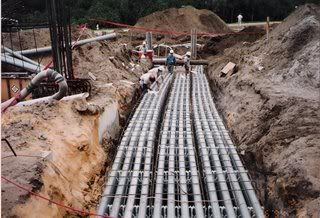- Location
- Illinois
- Occupation
- retired electrician
Actually about 30 years ago the Canadian Electrical Code required the use of tapered thread conduit couplings, but under pressure from the major conduit manufacturer's their code was changed to permit the use of the much cheaper to manufacture straight thread couplings. One of the complaints that the conduit manufacturers received after that change was that the conduit now leaked water.Unfortunately, rigid couplings (as made up standard without thread sealants or conductive pipe dope) are not technically watertight (as in a standard plumbing application - matching tapered fitting and pipe thread). The primary reason is that the straight thread couplings do not have matching tapered conduit threads. Standard, three piece unions also do very little in keeping rain out due to non-gasketed junctions. This probably constitutes a majority of the water intrusion locations within a run of rigid conduit. The standard straight coupling could be made with tapered threads, but it would certainly increase the cost - which many won't pay for. We already have a solution for a RT 3-pc coupling which we offer.
On the other hand, conduit bodies and entrance hubs have tapered threads, gaskets, and are listed as raintight. So are some compression fittings.
Perhaps one day, there will be a Raintight requirement for these types of standard threaded rigid fittings when used outside.
I am sure that the 3 piece raintight coupling would be much more expensive than a tapered thread coupling as well as the additional labor costs that are required to install a 3 piece coupling over that required to install a standard type coupling.
Neither the code nor the listings require that the rigid couplings be water tight and therefore we need to provide some method of draining the water. Yes, there are drain fittings made for the purpose, but often in industrial applications, there is no room to install the tee fitting that is required to use them so a common practice is to drill a small hole in a conduit body or notch the conduit body gasket.
As far as the conduit bodies and threaded enclosures having tapered threads, that may be part of the problem. If these threads were straight threads, maybe the water could drain out on its own.
This whole issue of the newer UL standard that requires the use of watertight EMT connectors and couplings in wet locations has always puzzled me in light of the fact that a rigid coupling is not watertight and are permitted to be installed in wet locations.



